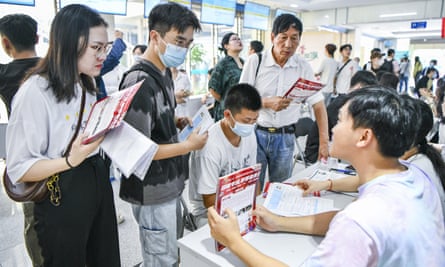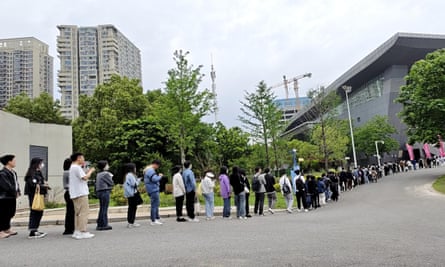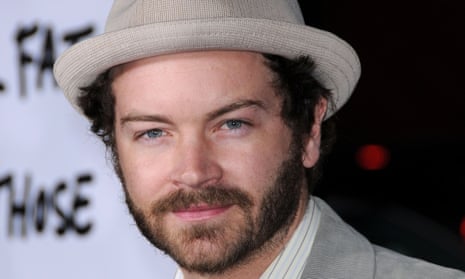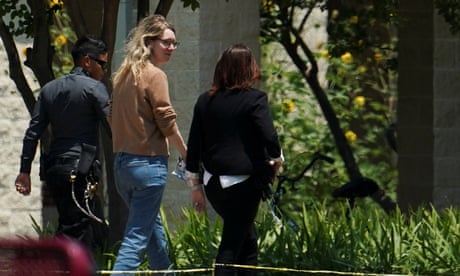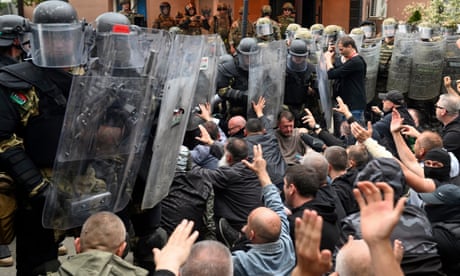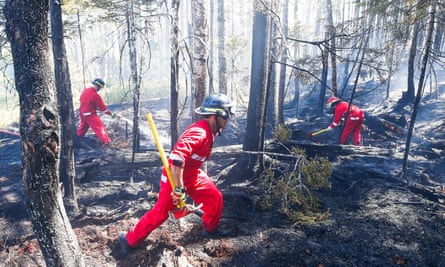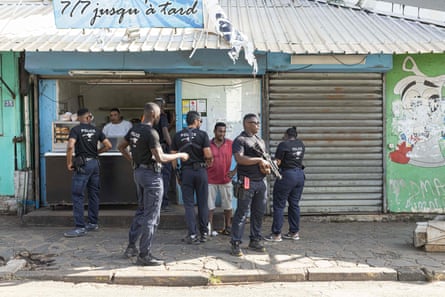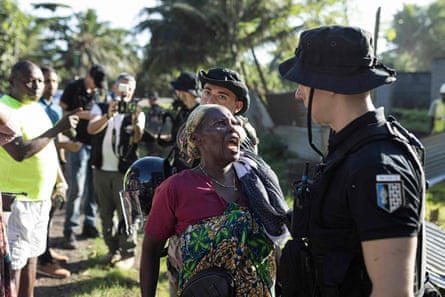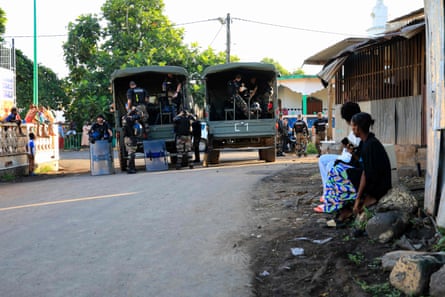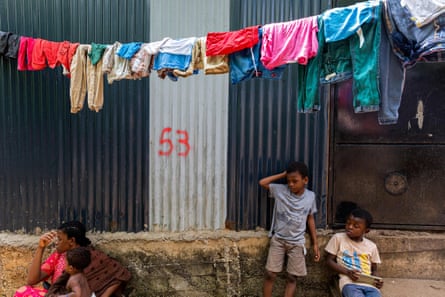María Teresa Montaño Delgado was kidnapped while investigating suspicious contracts worth $300m awarded by the state of Mexico
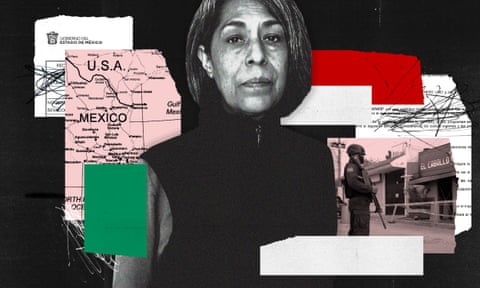
María Teresa Montaño Delgado was kidnapped while investigating suspicious government contracts in the state of Mexico. Composite: Guardian Design/Alamy
LONG READ
by Nina Lakhani in Mexico City
THE GUARDIAN
Wed 31 May 2023
It was a muggy summer day when the veteran reporter María Teresa Montaño Delgado drove almost 450 miles from Toluca, capital of the state of Mexico (Edomex), to a rundown neighbourhood in Coatzacoalcos, an oil city on the Gulf coast.
Montaño carried with her a $35m contract for “specialist human capital management” with the government of Edomex – the last bastion of power for the Institutional Revolutionary Party (PRI) which has ruled the state uninterrupted for almost a century.
She double-checked the company address, which turned out to be a second-floor apartment in a pastel-pink residential building, on an unremarkable street with boarded-up bars and empty lots.
The company, one half of a consortium with contracts with three agencies worth about $55m – existed on paper, but there was no sign of any business operations or employees.
“I was shocked by the crumbling building, but it confirmed my suspicions: the contract was completely illogical,” said Montaño, founder and editor-in-chief of the independent news website the Observer. “This was a fake company, part of a scheme to embezzle huge amounts of public money … That’s why they tried to silence me.”
Coatzacoalcos seemed an unlikely location for a human resources company with multimillion-dollar contracts on the other side of the country. All the contracts were signed on 29 December 2018, at a time when a vicious turf war between rival cartels had helped make the port city one of the most violent places in Mexico.
When the Guardian visited in January, the seafront boulevard was lined with burned-out hotels, abandoned shopping malls and decrepit housing blocks, and the streets patrolled by marines. A few courageous women were out selling seafood cocktails and coconuts, but it looked like a hurricane had swept through downtown.
The $55m contracts weren’t the only questionable deals that Montaño had uncovered while trawling through the government’s information portal. In early 2021, Montaño had noticed other contracts worth millions of dollars with companies and individuals across Mexico – many for vaguely defined products and services available locally such as cleaning, office furniture, construction and computer software.
On paper, the companies and contracts looked legitimate but there were multiple “red flags”, according to Muna Dora Buchahin Abulhosn, a forensic accountant who has led investigations into state-run embezzlement schemes.
A cursory search on Google Maps found companies awarded lucrative contracts were often located in residential streets, abandoned lots and shopping malls. Some addresses were linked to several companies – or didn’t exist; other companies had no functioning website despite multimillion dollar contracts.
Montaño’s reporting was potentially embarrassing for the PRI, which is desperate to hold on to the state in elections on 4 June. But investigating corruption can be deadly in Mexico, particularly for local reporters.
Last year 15 journalists were killed in Mexico, making it the most dangerous country for the media apart from Ukraine. The violence – and the impunity that fuels it – has a chilling effect, with reporters routinely silenced by threats, bribes and blacklists blocking access to jobs and information.
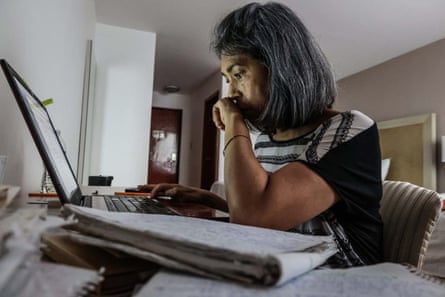
It was a muggy summer day when the veteran reporter María Teresa Montaño Delgado drove almost 450 miles from Toluca, capital of the state of Mexico (Edomex), to a rundown neighbourhood in Coatzacoalcos, an oil city on the Gulf coast.
Montaño carried with her a $35m contract for “specialist human capital management” with the government of Edomex – the last bastion of power for the Institutional Revolutionary Party (PRI) which has ruled the state uninterrupted for almost a century.
She double-checked the company address, which turned out to be a second-floor apartment in a pastel-pink residential building, on an unremarkable street with boarded-up bars and empty lots.
The company, one half of a consortium with contracts with three agencies worth about $55m – existed on paper, but there was no sign of any business operations or employees.
“I was shocked by the crumbling building, but it confirmed my suspicions: the contract was completely illogical,” said Montaño, founder and editor-in-chief of the independent news website the Observer. “This was a fake company, part of a scheme to embezzle huge amounts of public money … That’s why they tried to silence me.”
Coatzacoalcos seemed an unlikely location for a human resources company with multimillion-dollar contracts on the other side of the country. All the contracts were signed on 29 December 2018, at a time when a vicious turf war between rival cartels had helped make the port city one of the most violent places in Mexico.
When the Guardian visited in January, the seafront boulevard was lined with burned-out hotels, abandoned shopping malls and decrepit housing blocks, and the streets patrolled by marines. A few courageous women were out selling seafood cocktails and coconuts, but it looked like a hurricane had swept through downtown.
The $55m contracts weren’t the only questionable deals that Montaño had uncovered while trawling through the government’s information portal. In early 2021, Montaño had noticed other contracts worth millions of dollars with companies and individuals across Mexico – many for vaguely defined products and services available locally such as cleaning, office furniture, construction and computer software.
On paper, the companies and contracts looked legitimate but there were multiple “red flags”, according to Muna Dora Buchahin Abulhosn, a forensic accountant who has led investigations into state-run embezzlement schemes.
A cursory search on Google Maps found companies awarded lucrative contracts were often located in residential streets, abandoned lots and shopping malls. Some addresses were linked to several companies – or didn’t exist; other companies had no functioning website despite multimillion dollar contracts.
Montaño’s reporting was potentially embarrassing for the PRI, which is desperate to hold on to the state in elections on 4 June. But investigating corruption can be deadly in Mexico, particularly for local reporters.
Last year 15 journalists were killed in Mexico, making it the most dangerous country for the media apart from Ukraine. The violence – and the impunity that fuels it – has a chilling effect, with reporters routinely silenced by threats, bribes and blacklists blocking access to jobs and information.

María Teresa Montaño writes on her computer. Photograph: Ginnette Riquelme/Ginnette Riquelme for The Guardian
“The contracts were signed with companies far away to make it almost impossible for local journalists to physically verify. The government has so much control but I kept asking questions and downloading documents,” said Montaño. “That’s why I think I was kidnapped.”
On 13 August 2021, Montaño’s car broke down en route to a medical appointment in Toluca. She left it parked at a convenience store and took a bus to the clinic, close to the state congress building which is surrounded by surveillance cameras.
By the time she was finished it was just after 7.30pm. A huge rainstorm had broken and Montaño was soaking wet, when a white car that looked like a shared taxi signalled for her to get in.
Almost immediately, a skinny man in the passenger seat pulled out a revolver. “Don’t scream and you won’t die,” he said. In the back, a second man covered her eyes with her Covid mask and pulled up her jersey to expose her stomach and chest.
The driver added: “You’re the journalist, aren’t you?”
Fearing for her life, Montaño denied she was a reporter, but the kidnappers knew where she lived and even where she’d left her car.
“Is your son home?” the driver asked as they pulled up at her gated housing complex.

“The contracts were signed with companies far away to make it almost impossible for local journalists to physically verify. The government has so much control but I kept asking questions and downloading documents,” said Montaño. “That’s why I think I was kidnapped.”
On 13 August 2021, Montaño’s car broke down en route to a medical appointment in Toluca. She left it parked at a convenience store and took a bus to the clinic, close to the state congress building which is surrounded by surveillance cameras.
By the time she was finished it was just after 7.30pm. A huge rainstorm had broken and Montaño was soaking wet, when a white car that looked like a shared taxi signalled for her to get in.
Almost immediately, a skinny man in the passenger seat pulled out a revolver. “Don’t scream and you won’t die,” he said. In the back, a second man covered her eyes with her Covid mask and pulled up her jersey to expose her stomach and chest.
The driver added: “You’re the journalist, aren’t you?”
Fearing for her life, Montaño denied she was a reporter, but the kidnappers knew where she lived and even where she’d left her car.
“Is your son home?” the driver asked as they pulled up at her gated housing complex.

A residential building in Coatzacoalcos, at the address on a $35m contract for ‘specialist human capital management’ signed by the government of the state of Mexico. Photograph: Nina Lakhani/The Guardian
The two assailants ransacked Montaño’s tiny home, before leaving her blindfolded on a dusty lot a few miles away at about 11pm. She had no phone and no money, but following a distant light, she found her way to a shopping mall and called her family.
She reported the kidnapping to the authorities immediately. It was only later that she realised the assailants had taken her laptops, phone, voice recorder, camera, notebooks and documents – but not the TV or other valuables.
“They stole my whole investigation. The message was clear, but I survived – and this information is too important to keep to myself. Before the people go to vote, they need to know.”
Over the past six months, the Guardian and Organized Crime and Corruption Reporting Project (OCCRP) have worked with Montaño as part of an initiative by the Paris-based non-profit Forbidden Stories to continue the work of threatened and murdered journalists.
The team analysed dozens of state contracts issued during the current administration led by Alfredo del Mazo Maza – whose family has governed Edomex for 29 years – visited every company address and consulted experts on corruption and politics in Mexico.
As Edomex prepares to go to the polls on 4 June, the investigation can reveal that the outgoing government issued at least 40 contracts involving at least 15 front and shell companies worth more than $300m.
In some cases there was no company at the listed address: no sign, no workers and no infrastructure. In others, real companies were contracted for goods or services they had no expertise in. Several companies shared the same address and/or legal representatives. Unusually, many were awarded at the end of the year when most government employees are on leave. Freedom of information requests for evidence on each procurement was ignored.
The Del Mazo government said that it complied with the law at all times and all contracts were awarded through competitive tender to the “best provider”; it said it respected press freedom and journalists, and had no prior knowledge of Montaño’s kidnap.
All the contracts were authorized by the department of finance, which coordinates the state’s procurement process. Approached by the consortium for comment, the department said it was obliged by law to open tenders to companies across the country, and provided a dossier of photocopies of undated photos and documents purporting to prove that all the contractors were legitimate.
But further investigation revealed multiple inconsistencies and irregularities in the government’s evidence, including offices which were apparently not in use, or addresses in use by seemingly unrelated companies.
Together, the contracts illustrate a pattern of “acts and omissions” that suggest an embezzlement scheme involving public officials and private individuals, according to Buchahin, the forensic accountant.
In Monterrey, a city 600 miles north of Toluca, the company Sevacom was contracted to provide materials for workshops – such as jewellery-making, balloon decorating and dressmaking – by six different government agencies, including the governor’s office and department of rural affairs. The consortium found 12 identical contracts worth almost $5.2m. There is a business called Sevacom at the address on the contract, but it is a retail store selling household cleaning products. The owner denied receiving any public contracts or any knowledge of workshops. A website for Sevacom was created after the first contracts were awarded, but telephone calls, letters and messages to the contact details it contains went unanswered.
In its dossier, the Edomex government provided photocopied photographs of an unidentified warehouse and women receiving boxes of government aid, as well as photocopies of a social security letter and documents provided by two commercial certification companies. It provided no evidence that any workshops had taken place.
The address listed on a half-million-dollar outsourcing contract with a supposed construction company in Edomex was actually a tiny house belonging to a woman with a makeshift neighbourhood nail salon, who said she had never heard of the deal. In another case, a nearly $100,000 contract for elevator maintenance was awarded to an audiovisuals company. The mismatch between the firm’s specialism and the contract it won was another red flag, said Buchahin
The supposed HR company in Coatzacoalcos, Instituto C&A Intelligent, was awarded another three contracts worth $67m with an address in Edomex that doesn’t exist. The company was listed online at a different but nearby location - an office building on which the company logo has appeared and disappeared several times this year. A phone number listed for the company is out of service, emails to its address bounced back and the company website is defunct.
The Edomex government provided copies of photographs showing people standing outside the building. Consortium reporters visited the site four times over the past year, but saw no sign of activity in the building. On Monday, a neighbour said he saw workers reattaching the company sign to the building’s facade last week, adding that the building was mostly empty apart from a few residential renters.
The address for a company awarded four contracts for office furniture worth a total of $2.4m is an unattended office in a strip mall on the outskirts of the city of Querétaro, 120 miles north-west of Edomex, with no answering machine. The government provided photocopies of photos showing stacks of furniture ostensibly taken at a company warehouse in the state of Puebla. The consortium visited the address, and found a modest metal workshop, whose employees said they had no knowledge of the company.
The findings suggest a new version of an old embezzlement scheme.
The two assailants ransacked Montaño’s tiny home, before leaving her blindfolded on a dusty lot a few miles away at about 11pm. She had no phone and no money, but following a distant light, she found her way to a shopping mall and called her family.
She reported the kidnapping to the authorities immediately. It was only later that she realised the assailants had taken her laptops, phone, voice recorder, camera, notebooks and documents – but not the TV or other valuables.
“They stole my whole investigation. The message was clear, but I survived – and this information is too important to keep to myself. Before the people go to vote, they need to know.”
Over the past six months, the Guardian and Organized Crime and Corruption Reporting Project (OCCRP) have worked with Montaño as part of an initiative by the Paris-based non-profit Forbidden Stories to continue the work of threatened and murdered journalists.
The team analysed dozens of state contracts issued during the current administration led by Alfredo del Mazo Maza – whose family has governed Edomex for 29 years – visited every company address and consulted experts on corruption and politics in Mexico.
As Edomex prepares to go to the polls on 4 June, the investigation can reveal that the outgoing government issued at least 40 contracts involving at least 15 front and shell companies worth more than $300m.
In some cases there was no company at the listed address: no sign, no workers and no infrastructure. In others, real companies were contracted for goods or services they had no expertise in. Several companies shared the same address and/or legal representatives. Unusually, many were awarded at the end of the year when most government employees are on leave. Freedom of information requests for evidence on each procurement was ignored.
The Del Mazo government said that it complied with the law at all times and all contracts were awarded through competitive tender to the “best provider”; it said it respected press freedom and journalists, and had no prior knowledge of Montaño’s kidnap.
All the contracts were authorized by the department of finance, which coordinates the state’s procurement process. Approached by the consortium for comment, the department said it was obliged by law to open tenders to companies across the country, and provided a dossier of photocopies of undated photos and documents purporting to prove that all the contractors were legitimate.
But further investigation revealed multiple inconsistencies and irregularities in the government’s evidence, including offices which were apparently not in use, or addresses in use by seemingly unrelated companies.
Together, the contracts illustrate a pattern of “acts and omissions” that suggest an embezzlement scheme involving public officials and private individuals, according to Buchahin, the forensic accountant.
In Monterrey, a city 600 miles north of Toluca, the company Sevacom was contracted to provide materials for workshops – such as jewellery-making, balloon decorating and dressmaking – by six different government agencies, including the governor’s office and department of rural affairs. The consortium found 12 identical contracts worth almost $5.2m. There is a business called Sevacom at the address on the contract, but it is a retail store selling household cleaning products. The owner denied receiving any public contracts or any knowledge of workshops. A website for Sevacom was created after the first contracts were awarded, but telephone calls, letters and messages to the contact details it contains went unanswered.
In its dossier, the Edomex government provided photocopied photographs of an unidentified warehouse and women receiving boxes of government aid, as well as photocopies of a social security letter and documents provided by two commercial certification companies. It provided no evidence that any workshops had taken place.
The address listed on a half-million-dollar outsourcing contract with a supposed construction company in Edomex was actually a tiny house belonging to a woman with a makeshift neighbourhood nail salon, who said she had never heard of the deal. In another case, a nearly $100,000 contract for elevator maintenance was awarded to an audiovisuals company. The mismatch between the firm’s specialism and the contract it won was another red flag, said Buchahin
The supposed HR company in Coatzacoalcos, Instituto C&A Intelligent, was awarded another three contracts worth $67m with an address in Edomex that doesn’t exist. The company was listed online at a different but nearby location - an office building on which the company logo has appeared and disappeared several times this year. A phone number listed for the company is out of service, emails to its address bounced back and the company website is defunct.
The Edomex government provided copies of photographs showing people standing outside the building. Consortium reporters visited the site four times over the past year, but saw no sign of activity in the building. On Monday, a neighbour said he saw workers reattaching the company sign to the building’s facade last week, adding that the building was mostly empty apart from a few residential renters.
The address for a company awarded four contracts for office furniture worth a total of $2.4m is an unattended office in a strip mall on the outskirts of the city of Querétaro, 120 miles north-west of Edomex, with no answering machine. The government provided photocopies of photos showing stacks of furniture ostensibly taken at a company warehouse in the state of Puebla. The consortium visited the address, and found a modest metal workshop, whose employees said they had no knowledge of the company.
The findings suggest a new version of an old embezzlement scheme.

María Teresa Montaño, smokes a cigarette while walking during a break. Photograph: Ginnette Riquelme/Ginnette Riquelme for The Guardian
In 2017, the Federal Audit Office (ASF) and investigative journalists uncovered an alleged multimillion-dollar embezzlement enterprise involving at least 11 federal government agencies, eight public universities and more than 120 fake companies registered in several states. The case, known as La estafa maestra or the master swindle, took place during the presidency of Enrique Peña Nieto, former governor of Edomex – and Del Mazo’s cousin.
No one was ever charged over the allegations, which implicated several institutions and PRI officials in Edomex. Peña Nieto has denied any wrongdoing.
In 2017, the Federal Audit Office (ASF) and investigative journalists uncovered an alleged multimillion-dollar embezzlement enterprise involving at least 11 federal government agencies, eight public universities and more than 120 fake companies registered in several states. The case, known as La estafa maestra or the master swindle, took place during the presidency of Enrique Peña Nieto, former governor of Edomex – and Del Mazo’s cousin.
No one was ever charged over the allegations, which implicated several institutions and PRI officials in Edomex. Peña Nieto has denied any wrongdoing.
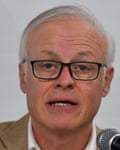
Eric Sevilla. Photograph: Future Publishing/Getty Images
Such impunity has allowed the “modus operandi” to continue, said Buchahin, who previously led the ASF forensic accounting unit. Some of the companies implicated in the estafa maestra continue to receive government contracts, while officials suspected of wrongdoing were simply moved to new roles.
Such impunity has allowed the “modus operandi” to continue, said Buchahin, who previously led the ASF forensic accounting unit. Some of the companies implicated in the estafa maestra continue to receive government contracts, while officials suspected of wrongdoing were simply moved to new roles.

Alejandra del Moral. Photograph: Marco Ugarte/AP
Nine of the 40 contracts analysed by the Guardian involved the Edomex department of social development. Alejandra del Moral, who led the department in 2022, is running for governor. Eric Sevilla Montes de Oca, the 2018-2020 director, is currently president of the PRI in Edomex and running the governor’s election campaign. Neither Sevilla nor Del Moral responded to the allegations.
“This is a network of powerful senior officials who simulate contracts and payments which are supported by legal but unsupported invoices in order to get money out … It continues because they know nothing will happen, impunity is generalised. Everybody knows and nobody does anything. The state of Mexico is the most corrupt in the country, it’s where they get money for all the others,” said Buchahin.
Edomex is Mexico’s largest state by population, with 17 million people: a sprawling conurbation of dormitory communities, industrial sites and colonial pueblos wrapping around the capital city. It is home to members of the political, economic and criminal elites, but includes some of the country’s most dangerous municipalities – especially for women and girls.
Del Mazo Maza – whose grandfather, father and uncle have also governed the state – eked out an election victory in 2017 amid widespread allegations of fraud. Next week’s election matters because Edomex is the only state that the PRI – which ruled the country uninterrupted between 1929 and 2010 – has clung on to.
Nine of the 40 contracts analysed by the Guardian involved the Edomex department of social development. Alejandra del Moral, who led the department in 2022, is running for governor. Eric Sevilla Montes de Oca, the 2018-2020 director, is currently president of the PRI in Edomex and running the governor’s election campaign. Neither Sevilla nor Del Moral responded to the allegations.
“This is a network of powerful senior officials who simulate contracts and payments which are supported by legal but unsupported invoices in order to get money out … It continues because they know nothing will happen, impunity is generalised. Everybody knows and nobody does anything. The state of Mexico is the most corrupt in the country, it’s where they get money for all the others,” said Buchahin.
Edomex is Mexico’s largest state by population, with 17 million people: a sprawling conurbation of dormitory communities, industrial sites and colonial pueblos wrapping around the capital city. It is home to members of the political, economic and criminal elites, but includes some of the country’s most dangerous municipalities – especially for women and girls.
Del Mazo Maza – whose grandfather, father and uncle have also governed the state – eked out an election victory in 2017 amid widespread allegations of fraud. Next week’s election matters because Edomex is the only state that the PRI – which ruled the country uninterrupted between 1929 and 2010 – has clung on to.

Governor Alfredo del Mazo Maza. Photograph: Mario Guzman/EPA
“The state of Mexico has both great political and symbolic value for the PRI – and their opponents,” said Rogelio Hernández, a political scientist at the College of Mexico. For the PRI, retaining the state would prove that it is still relevant as a party; for Morena – the party which is in government nationally but in opposition in the state – a victory would be a much-needed token of support for President Andrés Manuel López Obrador.
PRI’s success in Edomex is partly down to its control of the media. Most news outlets – and many journalists – depend on the state government for advertising and off-the-books monthly payments, known as chayotes, in exchange for non-critical coverage.
“Intimidating journalists has been a constant for many decades in the state of Mexico – just like chayotes. It’s how the PRI has been able to remain in power, and why there is virtually zero independent and investigative journalism in the state,” said Lenin Martell, media studies professor at the autonomous university of the state of Mexico.
Journalists who reject the status quo often pay a great personal and professional price.
Montaño has spent her whole career reporting on politics, crime and corruption in Edomex, mostly as a correspondent for national newspapers, and has a track record of irking powerful people.
But after refusing to accept an envelope of cash in early 2018, she started getting pressure from editors to send fewer freedom of information requests. Colleagues and sources cut her off and it became harder to make ends meet.
After the kidnap, she left Mexico for several months but returned determined to continue the investigation. Despite CCTV footage of at least one assailant withdrawing cash using her bank card, no one has been arrested. Prosecutors investigating the case have denied that the kidnapping was related to her journalism.
A spokesperson for the Del Mazo government said that it fully “complied with the law at all times with its transparency and accountability obligations” and that procurements for all goods and services had been consolidated under the finance department “to obtain technical and economic advantages”. The government did not respond to specific questions about the investigation’s conclusions, or the use of threats, publicity and payments to control the media.

Mexico media say president’s attacks on journalists are ‘invitation to violence’
The finance department said that all contracts were awarded through competitive tender to the “best provider” regardless of their location, taking into account factors including price, quality and financing, and that the process was supported by an oversight committee.
“It’s a miracle that María Teresa has continued reporting in a state totally controlled by mafia politicians, where government publicity is disguised as journalism and independent reporters are isolated and punished, leaving the public with a huge black information hole,” said Marcela Turati, co-founder of investigative news site Quinto Elemento Lab. “The violence continues because impunity is guaranteed.”
Reporting team, María Teresa Montaño Delgado (El Observador), Lilia Saúl Rodríguez (OCCRP) and Nina Lakhani. Additional reporting by Aïda Delpuech and Paloma Dupont de Dinechin (Forbidden Stories)
“The state of Mexico has both great political and symbolic value for the PRI – and their opponents,” said Rogelio Hernández, a political scientist at the College of Mexico. For the PRI, retaining the state would prove that it is still relevant as a party; for Morena – the party which is in government nationally but in opposition in the state – a victory would be a much-needed token of support for President Andrés Manuel López Obrador.
PRI’s success in Edomex is partly down to its control of the media. Most news outlets – and many journalists – depend on the state government for advertising and off-the-books monthly payments, known as chayotes, in exchange for non-critical coverage.
“Intimidating journalists has been a constant for many decades in the state of Mexico – just like chayotes. It’s how the PRI has been able to remain in power, and why there is virtually zero independent and investigative journalism in the state,” said Lenin Martell, media studies professor at the autonomous university of the state of Mexico.
Journalists who reject the status quo often pay a great personal and professional price.
Montaño has spent her whole career reporting on politics, crime and corruption in Edomex, mostly as a correspondent for national newspapers, and has a track record of irking powerful people.
But after refusing to accept an envelope of cash in early 2018, she started getting pressure from editors to send fewer freedom of information requests. Colleagues and sources cut her off and it became harder to make ends meet.
After the kidnap, she left Mexico for several months but returned determined to continue the investigation. Despite CCTV footage of at least one assailant withdrawing cash using her bank card, no one has been arrested. Prosecutors investigating the case have denied that the kidnapping was related to her journalism.
A spokesperson for the Del Mazo government said that it fully “complied with the law at all times with its transparency and accountability obligations” and that procurements for all goods and services had been consolidated under the finance department “to obtain technical and economic advantages”. The government did not respond to specific questions about the investigation’s conclusions, or the use of threats, publicity and payments to control the media.

Mexico media say president’s attacks on journalists are ‘invitation to violence’
The finance department said that all contracts were awarded through competitive tender to the “best provider” regardless of their location, taking into account factors including price, quality and financing, and that the process was supported by an oversight committee.
“It’s a miracle that María Teresa has continued reporting in a state totally controlled by mafia politicians, where government publicity is disguised as journalism and independent reporters are isolated and punished, leaving the public with a huge black information hole,” said Marcela Turati, co-founder of investigative news site Quinto Elemento Lab. “The violence continues because impunity is guaranteed.”
Reporting team, María Teresa Montaño Delgado (El Observador), Lilia Saúl Rodríguez (OCCRP) and Nina Lakhani. Additional reporting by Aïda Delpuech and Paloma Dupont de Dinechin (Forbidden Stories)


